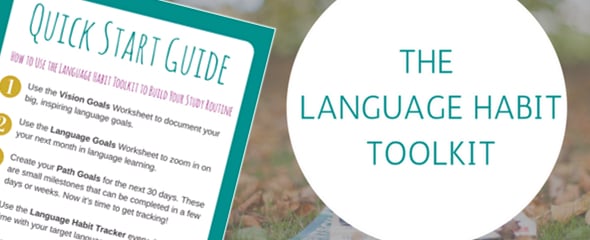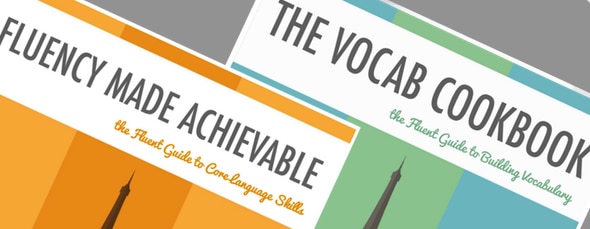
This article was originally posted on WomenLearnThai.com.
"*" indicates required fields
The Language Habit Toolkit: For when your language habits suck swampwater…
Immediately after commiserating with a friend about how abysmal our language studies were going, I happened across a post by Chiara from Runaway Daydreamer: How I created my ideal language learning routine with the Language Habit Toolkit.
The Language Habit Toolkit is all about getting organized and creating a language routine. It is designed to track your progress and it includes five wonderfully designed worksheets to evaluate and plan.
Talk about my good luck! I was not only looking for a way to get my study habits under control but I just happen to love making lists and filling out stuff.
And as I’ve long been a fan of the author of the Language Habit Toolkit, Kerstin Cable (language coach at Fluent Language), I already trust her advice.
In addition to the Language Habit Toolkit, Kerstin wrote the popular Fluency Made Achievable: The Fluent Guide to Core Language Skills and The Vocab Cookbook: The Fluent Guide to Building Foreign Language Vocabulary. Both are in my language learning bookcase.

And I kid you not, Kerstin’s online course, Focus & Fluency, was written with me in mind (I suffer from having too much language learning stuff). Talk about back-to-back “ah hah’s!” All through the course I laughed, grinned, and nodded in agreement. The F&F was just what I needed pre getting stuck into the Language Habit Toolkit.
Before I get started into my review, here’s a few tips from Kerstin to help you with toolkit (paraphrasing):
Ultimately the main goal is to create a language learning habit. It starts with a question: Where do you want to be and what do you want to achieve?
Goals are snapshot of where you are right now. They are also a clear and measurable roadmap. But goals are not set in stone; they are flexible. They will serve you as you change and as you grow. Don’t beat yourself up if a goal changes or becomes irrelevant.
Goals are not a way to compare yourself to others. Your goals don’t have to live up to anybody else’s. Instead, look inwards in order to create the best goals for you.
Focus on the process instead of the outcome. Trust yourself. Don’t feel discouraged if your outcome doesn’t quite match what you thought it would, as long as you did the work. Celebrate the effort you are making because that is where you are growing.
REVIEW: Language Habit Toolkit…
Right away I was impressed at how beautifully designed the toolkit is (blame the designer in me). And after going through each item (book, guide, worksheets and video), it’s clear to see how Kerstin’s expertise on the subject makes the toolkit what it is: A practical and highly useful resource for planning a workable route to serious language study.
This is what comes with the toolkit:
The Language Habit Handbook PDF.pdf
The Language Habit Handbook epub.epub
Language Habit Toolkit Quick Start Guide.png
Video Goal Setting Guide.m4v
1 – Vision Goals Worksheet.pdf
1 – Vision Goals Worksheet (for on-screen edits).pdf
2 – Language Goals Worksheet.pdf
2 – Language Goals Worksheet (for on-screen edits).pdf
3 – Language Habit Tracker.pdf
4 – Study Tracker.pdf
5 – Your Month in Review Worksheet.pdf
5 – Your Month in Review Worksheet (for on-screen edits).pdf
So with the Language Habit Handbook you are given a choice of reading it either via epub or pdf. The Vision Goals Worksheet, Language Goals Worksheet and Your Month in Review Worksheet can either be printed out and filled in by hand, or filled in on your computer (pretty nifty if you ask me).
TIP: If you are going the computer route and don’t intend on printing out your results, either first make copies of the three pdfs (Vision Goals, Language Goals and Your Month in Review) or make copies at the end of the month (but be prepared to tweak/delete). At the beginning of the new month my Vision Goals stayed the same, Language Goals needed a tweak (not a total rewrite), and Month in Review was given a clean slate.
How to use the Language Habit Toolkit…
When I started the Language Habit Toolkit I had ten days left in the month so I decided to use those days to get my head around the program. Below is a quick rundown of how I see using the materials.
1) First read the The Language Habit Handbook (pdf or epub), print out the Language Habit Toolkit Quick Start Guide (png), and watch the Video Goal Setting Guide (m4v).
I found all three inspiring. I haven’t been fond of watching instructional videos but due to writing this review I sat it out. And I’m glad I took the time because Kerstin’s natural way of communicating her experience with language learning fired me up. I now plan on getting further advice by watching her videos on the Facebook group dedicated to the Language Habit Toolkit.
2) Next fill out the Vision Goals Worksheet (print or digital). This sheet has you select your current level (I love that ‘it’s been awhile’ is included along with A1-C2), list resources that inspire you, include where you dream of ending up (comfortable to fluid, whatever) and how you’ll feel once you reach that level. In addition to the above, you also jot down three goals to keep you motivated.
Now, if you fill this section out as intended, you just might feel an emotional high like I did. At one point I even found myself giggling.
And a bonus, when filling out ‘My Sources of Inspiration’ I decided that needed another local musician so I asked my StudyBuddy for suggestions. I’m now a fan of yet another impressive talent (only female this time). Win. Win.
3) Then up comes the Language Goals Worksheet (print or digital). The This Month in Language section of the worksheet is for you to clarify where you are now and where you want to be by the end of the month. And the Path Goals section is to decide what you plan to do to practice your core skills (reading, listening, speaking and writing).
Tip from Kerstin: “the whole idea behind your Path Goals is to move you gradually towards your Vision Goals”.
What I especially enjoyed about this section is knowing that at the end of each month I check this sheet to evaluate what has worked (or not) and make adjustments for the following month. So if it isn’t fun, turf it out! Sweet.
4) The Language Habit Tracker (print only) is a language learning log. Print out enough copies for the month to jot down daily Study Sessions (big or small), daily Practice Sentences and Things to Look Up (and review at the end of the month).
5) The Study Tracker (print only) is a study log where you document the basics: The date, what you did, core skills studied, tools you used, how much time you’ve spent on your studies, and what you learned.
I wanted to add more detail so in Pages (Mac doc software) I created a custom version of the Study Tracker. In the doc I added movies and Youtube videos watched, chapters read, lessons rewritten to suit my interests, lessons completed, words and phrases to study, etc. Later I merged it with the Language Habit Tracker after the modified tracker gave me ideas for a new direction in my studies.
6) In the This Month in Review sheet (print or digital) you look back through the other sheets to fill in the goals you accomplished for the month, what went well, what didn’t go so hot, how much time you spent on each of the core skills (writing, reading, listening and speaking), etc. This is where you can get an understanding of what wasn’t working, what might need to be shuffled around, and/or what else can be added.
Note to self: I can see how I’d benefit from a This Week in Review sheet as well as a monthly review. It’s a thought anyway (we’ll have to see).
Fluent Language and the Language Habit Toolkit…
If you are interested in trying it out the toolkit it can be purchased on FluentLanguage at Language Habit Toolkit.
Kerstin: The Language Habit Toolkit is a set of tools that focus on the two most important ingredients you need to develop persistence: setting helpful goals and keeping an eye on the time you spend studying a language. Use these tracking tools every day, and soon you will have built a language learning habit that’s difficult to quit.
Website: Fluent Language
Blog: Fluent Language Blog
Facebook: Fluent Language
Facebook: Fluent Language Learners
twitter: @fluentlanguage






